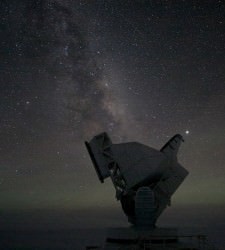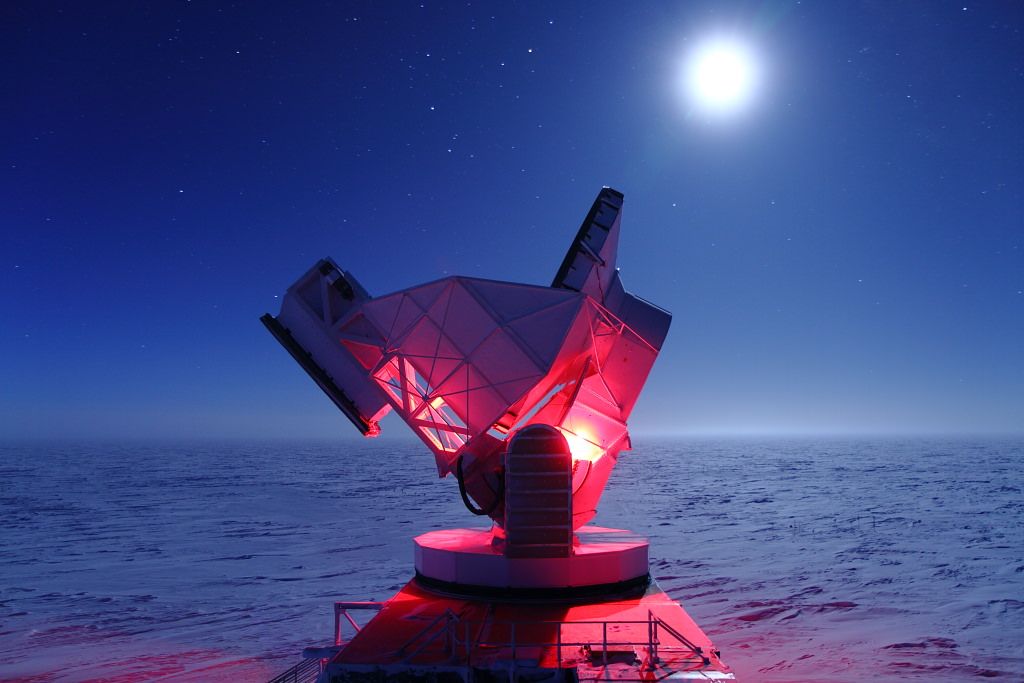[/caption]
Located at the southermost point on Earth, the 280-ton, 10-meter-wide South Pole Telescope has helped astronomers unravel the nature of dark energy and zero in on the actual mass of neutrinos — elusive subatomic particles that pervade the Universe and, until very recently, were thought to be entirely without measureable mass.
The NSF-funded South Pole Telescope (SPT) is specifically designed to study the secrets of dark energy, the force that purportedly drives the incessant (and apparently still accelerating) expansion of the Universe. Its millimeter-wave observation abilities allow scientists to study the Cosmic Microwave Background (CMB) which pervades the night sky with the 14-billion-year-old echo of the Big Bang.
Overlaid upon the imprint of the CMB are the silhouettes of distant galaxy clusters — some of the most massive structures to form within the Universe. By locating these clusters and mapping their movements with the SPT, researchers can see how dark energy — and neutrinos — interact with them.
“Neutrinos are amongst the most abundant particles in the universe,” said Bradford Benson, an experimental cosmologist at the University of Chicago’s Kavli Institute for Cosmological Physics. “About one trillion neutrinos pass through us each second, though you would hardly notice them because they rarely interact with ‘normal’ matter.”
If neutrinos were particularly massive, they would have an effect on the large-scale galaxy clusters observed with the SPT. If they had no mass, there would be no effect.
The SPT collaboration team’s results, however, fall somewhere in between.
Even though only 100 of the 500 clusters identified so far have been surveyed, the team has been able to place a reasonably reliable preliminary upper limit on the mass of neutrinos — again, particles that had once been assumed to have no mass.
Previous tests have also assigned a lower limit to the mass of neutrinos, thus narrowing the anticipated mass of the subatomic particles to between 0.05 – 0.28 eV (electron volts). Once the SPT survey is completed, the team expects to have an even more confident result of the particles’ masses.
“With the full SPT data set we will be able to place extremely tight constraints on dark energy and possibly determine the mass of the neutrinos,” said Benson.
“We should be very close to the level of accuracy needed to detect the neutrino masses,” he noted later in an email to Universe Today.

Such precise measurements would not have been possible without the South Pole Telescope, which has the ability due to its unique location to observe a dark sky for very long periods of time. Antarctica also offers SPT a stable atmosphere, as well as very low levels of water vapor that might otherwise absorb faint millimeter-wavelength signals.
“The South Pole Telescope has proven to be a crown jewel of astrophysical research carried out by NSF in the Antarctic,” said Vladimir Papitashvili, Antarctic Astrophysics and Geospace Sciences program director at NSF’s Office of Polar Programs. “It has produced about two dozen peer-reviewed science publications since the telescope received its ‘first light’ on Feb. 17, 2007. SPT is a very focused, well-managed and amazing project.”
The team’s findings were presented by Bradford Benson at the American Physical Society meeting in Atlanta on April 1.


i wonder how they power that thing down there?
seems perfect for wind driven hydraulic generators and sodium batteries.
is it remote or manned? what do they use for the data links?
the neutrino data reminds me of the puzzlement of first hearing the metric of mass described as one of energy (eV).
It’s probably all gas, gas & fotogen et cetera are the only things that work at those temperatures.
Why don’t use Wind-generators with a turbine in a electromagnetic suspension, in a sort of wind tunnels?
Then you don’t need any lubrication, if you don’t have any moving parts. And the cold is great for the magnets.
Yes, why not? I’m sure there are many techniques and new ideas that could be used, and they do seem to try, but it is expensive and difficult development.
I would think they have to do critical stuff in exploration mode, use reliable well tested equipment that are by their nature as little inventive as possible. Energy is survival critical, so I can’t blame them.
An estimate of neutrino contribution to DM is that they sum up to a mass with an upper bound about equal to all the mass of stars. So since DM is four times the mass of luminous matter this means a third of DM could be in the form of neutrinos. This component of DM must consist I think of both neutrinos and anti-neutrinos, or a Majorana form of neutrino. Otherwise the universe would have a strange excess of lepton numbers, in fact that excess would be enormous.
LC
Nice to know that when the basic Standard Model work peters out some 5 – 10 year hence, if and when a Standard Higgs has been found (later this year, hopefully) and verified/characterized (in perhaps 5 years, hopefully), non-Standard physics is on its way.
Time to take out the Cosmic Energy Inventory chart of Pössel. The neutrino background is ~ 0.001 of the total cosmic energy (and the stellar neutrinos orders of magnitude less), compared to ~ 0.23 parts for dark matter. Warm intergalactic plasma masses in at ~ 0.04 parts.
More exciting IMHO is that the CP symmetry breaking of neutrinos may or may not predict the matter excess over anti-matter in our universe. Go SPT!
Lessee.
Gravity is not a force. Hence, there is no force vector boson to carry a non-existent gravitational force. SUSY is FUBAR. Untestable String (M) theory is the next paradigm (11D+1T).
Just my shout out from the peanut gallery.
Neutrinos travel at the speed of light, and the effect of gravity on masses propagates at the speed of light, too.
As it is evident that Dark Matter does not travel at the speed of light, but stays with the Normal Matter the movement of which it controls by means of its gravity, it is also evident that neutrinos cannot contribute to the effects of Dark Matter.
It is true that these experiments, and I believe no experiment to date, can not distinguish between speed of photons in vacuum and speed of neutrinos anywhere.
However, it is now known that all neutrino species have a slight mass, I believe the last oscillation between species indicating mass was observed last year. So it is expected that when such measurements are done they would show a slightly lower speed for neutrinos.
When the supernova 1987A occurred, the neutrinos from that supernova came in at exactly the time when the first photons from that supernova were detected. That supernova took place some 169ooo lighyears away. Such, the speed difference between neutrinos and photons is less than 6,7E-10 c.
As neutrinos are that fast, they don´t stay where the mass stays they are expected to accumulate by the effect of their mass.